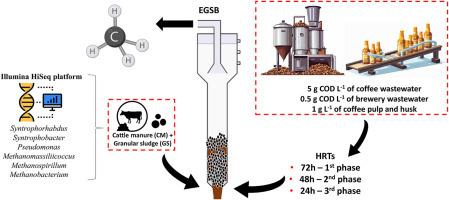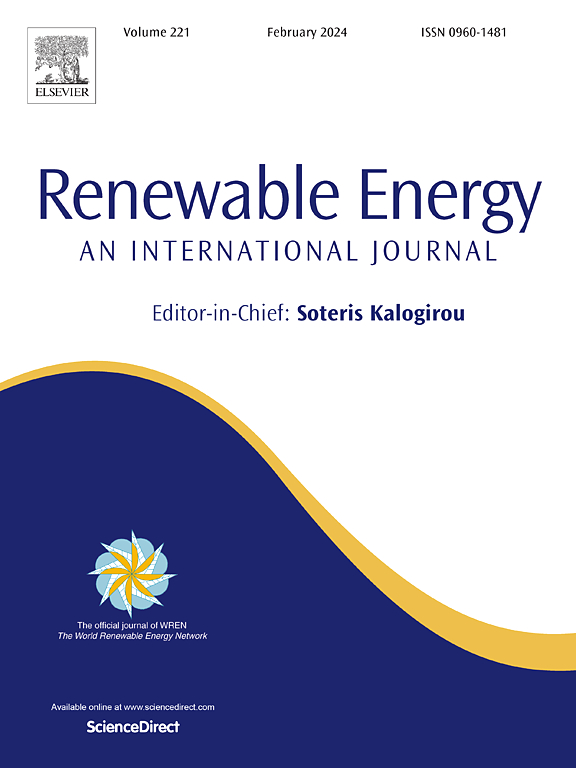New approach to agro-industrial solid and liquid waste management: Performance of an EGSB reactor at different hydraulic retention times for methane production
IF 9
1区 工程技术
Q1 ENERGY & FUELS
引用次数: 0
Abstract
This study investigated the removal of agro-industrial wastes (5 g COD L⁻1 from coffee and 0.5 g COD L⁻1 from brewery wastewater, plus 1 g L⁻1 of coffee pulp and husk) in a continuous Expanded Granular Sludge Bed (EGSB) reactor at 35 °C. The effect of Hydraulic Retention Times (HRTs) of 72h, 48h, and 24h on CH₄ yield was examined using a mixed culture of cattle manure and granular sludge. Methane yields were 201, 124.5, and 113.8 mL CH₄ g⁻1 COD for the 1st, 2nd, and 3rd phases, respectively. Volatile fatty acids, particularly acetic acid, increased at lower HRTs. Sequencing of the 16S rRNA gene on the Illumina HiSeq platform revealed a syntrophic relationship between Syntrophorhabdus, Syntrophobacter, and Pseudomonas with methanogens Methanomassiliicoccus, Methanospirillum, and Methanobacterium, aiding in the removal of phenolic compounds. The study suggests that an HRT of 72h is optimal for maximizing CH₄ production in the EGSB reactor.

农用工业固体和液体废物管理的新方法:不同水力停留时间下 EGSB 反应器生产甲烷的性能
本研究调查了在 35 °C、连续式膨胀颗粒污泥床(EGSB)反应器中去除农工业废物(5 g COD L-1 来自咖啡,0.5 g COD L-1 来自酿酒厂废水,外加 1 g L-1 的咖啡浆和咖啡壳)的情况。使用牛粪和颗粒污泥混合培养,考察了 72 小时、48 小时和 24 小时水力停留时间(HRT)对甲烷产量的影响。第一、第二和第三阶段的甲烷产量分别为 201、124.5 和 113.8 mL CH₄ g-1 COD。挥发性脂肪酸,尤其是乙酸,在较低的 HRTs 条件下有所增加。在 Illumina HiSeq 平台上对 16S rRNA 基因进行测序后发现,Syntrophorhabdus、Syntrophobacter 和假单胞菌与甲烷菌 Methanomassiliicoccus、Methanospirillum 和 Methanobacterium 之间存在合成营养关系,有助于酚类化合物的去除。研究表明,72 小时的 HRT 是使 EGSB 反应器中 CH₄ 产量最大化的最佳时间。
本文章由计算机程序翻译,如有差异,请以英文原文为准。
求助全文
约1分钟内获得全文
求助全文
来源期刊

Renewable Energy
工程技术-能源与燃料
CiteScore
18.40
自引率
9.20%
发文量
1955
审稿时长
6.6 months
期刊介绍:
Renewable Energy journal is dedicated to advancing knowledge and disseminating insights on various topics and technologies within renewable energy systems and components. Our mission is to support researchers, engineers, economists, manufacturers, NGOs, associations, and societies in staying updated on new developments in their respective fields and applying alternative energy solutions to current practices.
As an international, multidisciplinary journal in renewable energy engineering and research, we strive to be a premier peer-reviewed platform and a trusted source of original research and reviews in the field of renewable energy. Join us in our endeavor to drive innovation and progress in sustainable energy solutions.
 求助内容:
求助内容: 应助结果提醒方式:
应助结果提醒方式:


